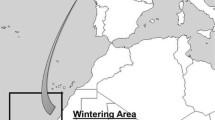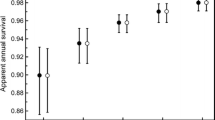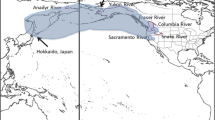Abstract
We analyzed a large dataset to quantify adult annual survival probability and remigration intervals for the Tortuguero, Costa Rica green turtle population. Annual survival probability was estimated at 0.85 (95% CI 0.75–0.92) using a recovery model and at 0.85 (95% CI 0.83–0.87) using an open robust design model. The two most common modes of remigration are 2 and 3 years. Annual survival probability is lower and remigration intervals are shorter than for other green turtle populations. Explanations for short remigration intervals include reproductive compensation due to historic population declines, availability of better quality food items, favorable environmental conditions, and short distance to the main foraging grounds. Variation in survival and remigration intervals have profound consequences for management and life history evolution. The short remigration intervals of Tortuguero green turtles partly offset mortality caused by turtle fishing in Nicaragua and mean that low juvenile survival represents a more urgent threat to the population than low adult survival. Low adult survival probability could result in selective pressure for earlier age at maturity.




Similar content being viewed by others
References
Balazs GH (1994) Homeward bound: satellite tracking of Hawaiian green turtles from nesting beaches to foraging pastures. NOAA Tech Memo NMFS-SEFSC-341:205–208
Balazs GH, Chaloupka M (2004) Spatial and temporal variability in somatic growth of green sea turtles (Chelonia mydas) resident in the Hawaiian Archipelago. Mar Biol 145:1043–1059
Balazs GH, Craig P, Winton BR, Miya RK (1994) Satellite telemetry of green turtles nesting at French Frigate Shoals, Hawaii, and Rose Atoll, American Samoa. NOAA Tech Memo NMFS-SEFSC-351:184–187
Bjorndal KA (1980) Demography of the breeding population of the green turtle, Chelonia mydas, at Tortuguero, Costa Rica. Copeia 1980(3):525–530
Bjorndal KA, Bolten AB, Chaloupka MY (2000) Green turtle somatic growth model: evidence for density dependence. Ecol Appl 10(1):269–282
Bjorndal KA, Bolten AB, Chaloupka MY (2003) Survival probability estimates for immature green turtles Chelonia mydas in the Bahamas. Mar Ecol Prog Ser 252:273–281
Broderick AC, Glen F, Godley BJ, Hays GC (2002) Estimating the number of green and loggerhead turtles nesting annually in the Mediterranean. Oryx 36(3):227–235
Broderick AC, Glen F, Godley BJ, Hays GC (2003) Variation in reproductive output of marine turtles. J Exp Mar Biol Ecol 288:95–109
Campbell CL (2003) Population assessment and management needs of a green turtle, Chelonia mydas, population in the western Caribbean. PhD dissertation, University of Florida Gainesville
Campbell CL, Lagueux CJ (2005) Survival probability estimates for large juvenile and adult green turtles (Chelonia mydas) exposed to an artisanal marine turtle fishery in the western Caribbean. Herpetologica 61(2):91–103
Carr A, Carr MH (1970) Modulated reproductive periodicity in Chelonia. Ecology 51(2):335–337
Carr A, Carr MH, Meylan AB (1978) The ecology and migrations of sea turtles, 7. The west Caribbean green turtle colony. B Am Mus Nat Hist 162:1–46
Chaloupka M (2002) Stochastic simulation modelling of southern Great Barrier Reef green turtle population dynamics. Ecol Model 148:79–109
Chaloupka M, Limpus C (2005) Estimates of sex- and age-class-specific survival probabilities for a southern Great Barrier Reef green sea turtle population. Mar Biol 146:1251–1261
Chaloupka M, Limpus C, Miller J (2004a) Green turtle somatic growth dynamics in a spatially disjunct Great Barrier Reef metapopulation. Coral Reefs 23:325–335
Chaloupka M, Parker D, Balazs G (2004b) Modelling post-release mortality of loggerhead sea turtles exposed to the Hawaii-based pelagic longline fishery. Mar Ecol Prog Ser 280:285–293
Cilimburg AB, Lindberg MS, Tewksbury JJ, Hejl SJ (2002) Effects of dispersal on survival probability of adult yellow warblers (Dendroica petechia). Auk 119(3):778–789
Congdon JD, Dunham AE, Van Loben Sels RC (1993) Delayed sexual maturity and demographics of Blanding’s turtles (Emydoidea blandingii): implications for conservation and management of long-lived organisms. Conserv Biol 7:826–833
Diaz JA, Delgado C, Figueroa A (2000) Reproductive biology of the black turtle in Michoacan, Mexico. NOAA Tech Memo NMFS-SEFSC-436:159
Dutton DL, Dutton PH, Chaloupka M, Boulon R (2005) Increase of a Caribbean leatherback Dermochelys coriacea nesting population linked to long-term nest protection. Biol Conserv 126:186–194
Frazer NB, Ladner RC (1986) A growth curve for green sea turtles, Chelonia mydas, in the U.S. Virgin Islands, 1913–1914. Copeia 1986:798–802
Godley BC, Richardson S, Broderick AC, Coyne MS, Glen F, Hays GC (2002) Long-term satellite telemetry of the movements and habitat utilisation by green turtles in the Mediterranean. Ecography 25:352–362
Hays GC (2000) The implications of variable remigration intervals for the assessment of population size in marine turtles. J Theor Biol 206:221–227
Hays GC (2004) Good news for sea turtles. TREE 19:349–351
Hays GC, Broderick AC, Godley BJ, Luschi P, Nichols WJ (2003) Satellite telemetry suggests high levels of fishing-induced mortality in marine turtles. Mar Ecol Prog Ser 262:305–309
Hirth HF (1997) Synopsis of the biological data on the green turtle Chelonia mydas (Linnaeus 1758). USFWS Biol Rep 97(1):1–120
IUCN (2004) 2004 IUCN Red List of Threatened Species. http://www.redlist.org. Downloaded on 06 September 2005
Jackson JBC, Kirby MX, Berger WG, Bjorndal KA, Botsford LW, Bourque BJ, Bradbury RH, Cooke R, Erlandson J, Estes JA, Hughes TP, Kidwell S, Lange CB, Lenihan HS, Pandolfi JM, Peterson CH, Steneck RS, Tegner MJ, Warner RR (2001) Historical overfishing and the recent collapse of coastal ecosystems. Science 293:629–638
Kendall WL, Bjorkland R (2001) Using open robust design models to estimate temporary emigration from capture-recapture data. Biometrics 57:1113–1122
Lagueux CJ (1998) Marine turtle fishery of Caribbean Nicaragua: human use patterns and harvest trends. PhD dissertation, University of Florida Gainesville
Limpus C, Nicholls N (2000) ENSO regulation of Indo-Pacific green turtle populations. In: Hammer GL, Nicholls N, Mitchell C (eds) The Australian experience. Kluwer Academic Publishers, Dordrecht, pp 399–408
Limpus CJ, Eggler P, Miller JD (1994) Long interval remigration in Eastern Australia Chelonia. NOAA Tech Memo NMFS-SEFSC-341:85–88
Limpus CJ, Miller JD, Parmenter CJ, Limpus DJ (2003) The green turtle, Chelonia mydas, population of Raine Island and the northern Great Barrier Reef: 1843–2001. Mem Qld Mus 49(1):349–440
Luschi P, Hays GC, Del Seppia C, Marsh R, Papi F (1998) The navigational feats of green sea turtles migrating from Ascension Island investigated by satellite telemetry. Proc Roy Soc Lond B 265:2279–2284
Mortimer JA (1981) The feeding ecology of the west Caribbean green turtle (Chelonia mydas) in Nicaragua. Biotropica 13(1):49–58
Mortimer JA, Carr AF (1987) Reproduction and migrations of the Ascension Island green turtle (Chelonia mydas). Copeia 1987(1):103–113
Pradel R, Hines JE, Lebreton JD, Nichols JD (1997) Capture-recapture survival models taking account of transients. Biometrics 53:60–72
Reina RD, Mayor PA, Spotila JR, Piedra R, Paladino FV (2002) Nesting ecology of the leatherback turtle, Dermochelys coriacea, at Parque Nacional Marino Las Baulas, Costa Rica: 1988–1989 to 1999–2000. Copeia 2002:653–664
Rivalan P, Prévot-Julliard AC, Girondot M (2004) The North Atlantic Oscillation drives the leatherback nesting season in French Guiana. NOAA Tech Memo (in press)
Rivalan P, Prévot-Julliard AC, Choquet R, Pradel R, Jacquemin B, Girondot M (2005) Trade-off between current reproductive effort and delay to next reproduction in the leatherback sea turtle. Oecologia 145:564–574
Seminoff J (2004) Marine Turtle Specialist Group Chelonia mydas Assessment. IUCN Marine Turtle Specialist Group
Seminoff JA, Resendiz A, Nichols WJ (2002) Home range of green turtles Chelonia mydas at a coastal foraging area in the Gulf of California, Mexico. Mar Ecol Prog Ser 242:253–265
Seminoff JA, Jones TT, Resendiz A, Nichols WJ, Chaloupka MY (2003) Monitoring green turtles (Chelonia mydas) at a coastal foraging area in Baja California, Mexico: multiple indices to describe population status. J Mar Biol Assoc UK 83:1355–1362
Shepherd TD, Myers RA (2005) Direct and indirect fishery effects on small coastal elasmobranchs in the northern Gulf of Mexico. Ecol Lett 8:1095–1104
Solow AR, Bjorndal KA, Bolten AB (2002) Annual variation in nesting numbers of marine turtles: the effect of sea surface temperature on remigration intervals. Ecol Lett 5:742–746
Spotila JR, Reina RD, Steyermark AC, Plotkin PT, Paladino FV (2000) Pacific leatherback turtles face extinction. Nature 405:529–530
Spring CS (1994) Satellite tracking green turtles in Australian waters—preliminary results. In: James R (comp) Proceedings of the Australian marine turtle conservation workshop. Australian National Parks and Wildlife Service, Canberra, pp 192–197
Tiwari M, Bjorndal KA, Bolten AB, Bolker BM (2005) Intraspecific application of the mid-domain effect model: spatial and temporal nest distributions of green turtles, Chelonia mydas, at Tortuguero, Costa Rica. Ecol Lett 8:918–924
Troëng S, Chaloupka M (2006) Evaluation of remigration intervals as indicators for how well sea turtle populations fulfill their ecological roles. In: Frick M, Panagopoulou A, Rees AF, Williams K (compilers) Book of abstracts. 26th annual symposium on sea turtle biology and conservation. International Sea Turtle Symposium, Athens, pp 176–177
Troëng S, Rankin E (2005) Long-term conservation of the green turtle Chelonia mydas nesting population at Tortuguero, Costa Rica. Biol Conserv 121:111–116
Troëng S, Chacón D, Dick B (2004) Possible decline in leatherback turtle Dermochelys coriacea nesting along the coast of Caribbean Central America. Oryx 38(4):395–403
Troëng S, Mangel J, Reyes C (2003) Comparison of Monel #49 and Inconel #681 tags loss in green turtles Chelonia mydas nesting at Tortuguero, Costa Rica. NOAA Tech Memo NMFS-SEFSC-503:121–122
Troëng S, Evans D, Harrison E, Lagueux C (2005) Migration of green turtles Chelonia mydas nesting at Tortuguero, Costa Rica. Mar Biol 148:435–447
Wetherall JA (1982) Analysis of double-tagging experiments. Fish Bull 80:687–701
White GC, Burnham KP (1999) Program MARK: Survival estimation from populations of marked animals. Bird Study 46(Suppl):120–138
Yasuda T, Arai N (2005) Fine-scale tracking of marine turtles using GPS-Argos PTTs. Zool Sci 22:547–553
Yasuda T, Tanaka H, Kittiwattanawong K, Mitamura H, Klom-in W, Arai N (2006) Do female green turtles (Chelonia mydas) exhibit reproductive seasonality in a year-round nesting rookery? J Zool 269:451–457
Zug GR, Balazs GH, Wetherall JA, Parker DM, Murakawa SKK (2002) Age and growth of Hawaiian green sea turtles (Chelonia mydas): an analysis based on skeletochronology. Fish B-NOAA 100:117–127
Acknowledgments
Thomas Alerstam, Jan-Åke Nilsson and two anonymous reviewers provided useful comments on a draft manuscript. Emma Harrison, Jeff Mangel, Catalina Reyes, Roldán Valverde and numerous research assistants and volunteers with CCC’s Green Turtle Program are acknowledged for their hard work to patrol and tag turtles. Tag recoveries were reported by fishers and other observers. We thank Cynthia Lagueux (WCS) for collecting the vast majority of tag recovery information. Peter Eliazar’s (ACCSTR) facilitating of tag information also deserves special mention. This study was conducted under a research permit issued by the Ministry of Environment and Energy of Costa Rica and complied with all relevant national legislation.
Author information
Authors and Affiliations
Corresponding author
Additional information
Communicated by M. Kühl.
Rights and permissions
About this article
Cite this article
Troëng, S., Chaloupka, M. Variation in adult annual survival probability and remigration intervals of sea turtles. Mar Biol 151, 1721–1730 (2007). https://doi.org/10.1007/s00227-007-0611-6
Received:
Accepted:
Published:
Issue Date:
DOI: https://doi.org/10.1007/s00227-007-0611-6




